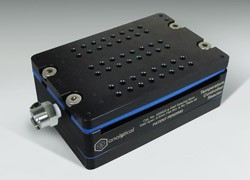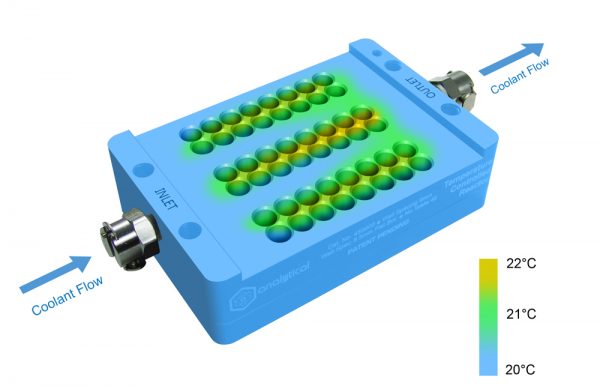Blog
Temperature Controlled Reactor
Published: September 16, 2022 Temperature control is a crucial parameter of chemical experimentation. This has proven to be problematic with high-throughput chemistry due to densely positioned reaction vessels that can produce “heat islands”, which can cause temperatures to vary by as much as 30°C. This is especially problematic for reactions performed around room temperature as this can lead to a reaction occurring orders of magnitude faster than another. A difference of reaction rates that large is unacceptably high for yield-sensitive applications and may impact experimental validity. Further, the heat island effect is reinforced by techniques like photocatalysis, which produces a large amount of waste heat and requires a more targeted cooling solution.
Temperature control is a crucial parameter of chemical experimentation. This has proven to be problematic with high-throughput chemistry due to densely positioned reaction vessels that can produce “heat islands”, which can cause temperatures to vary by as much as 30°C. This is especially problematic for reactions performed around room temperature as this can lead to a reaction occurring orders of magnitude faster than another. A difference of reaction rates that large is unacceptably high for yield-sensitive applications and may impact experimental validity. Further, the heat island effect is reinforced by techniques like photocatalysis, which produces a large amount of waste heat and requires a more targeted cooling solution.
To achieve a consistent thermal control range, methods such as temperature controlled baths to adjustable Peltier coolers on the bottom of reactors can come with their own problems. Due to their size, they can suffer from compatibility issues since the cooling methods need to be large enough to have the footprint necessary to control the temperature of a SLAS sized reactor. This further complicates the photocatalysis process since the resulting reactor and necessary cooling setup (along with peripherals) will not fit into any robot-assisted chemistry systems such as Chemspeed®, Tecan, etc.
These challenges require the use of a more sophisticated design to evenly control temperature while still maintaining broad compatibility and diversity of use. To address these issues, a device that left the top and bottom of the reactor free for robotic probes and lens mats was needed. To accomplish this, a single cooling circuit was proposed but brought with it its own challenges.
Any heat transfer simulation will show that utilizing fluid to cool a constant heat load often leaves a temperature gradient along the direction of travel. The warming of coolant as it travels along the heated surface results in the heated object to be much warmer near the outlet than the inlet. This temperature gradient is especially problematic for temperature sensitive applications. A work-around for this issue is to carefully manipulate the part geometry so that the thermal fluid does a more effective job of cooling at the outlet.
This geometric solution has the advantage of simplified operation, but the analytical complexity of it design is immense. An accurate solution for both the flow field and temperature distribution necessitates a solution of a set of partial differential equations over the whole problem domain. Since it is impossible to solve the equations for complex geometries by hand, computational fluid dynamics (also know as CFD) are a crucial component of the product development workflow. With the thermofluidic expertise of Analytical’s engineering department, we were able to efficiently converge upon a solution.
Below is an image of a prototype reactor and its thermal gradient. Note the temperature differences shown by the conjugate heat transfer simulation.
Analytical’s computational expertise has led to a Temperature Controlled Reactor (TCR) that is capable of achieving a near-zero thermal gradient with no moving parts, has leak resistant fittings to minimize fluid loss, and relies on meticulously designed channels and insulation geometry to ensure temperature uniformity. This not only simplifies the operation of the reactor, which allows the user to conduct experiments without worrying about complex part replacement, but also achieves the goal of decreasing the thermal gradient that is reflected in its operation.
As a leader in photocatalysis accessories, Analytical prioritized compatibility as one of the most important parameters of the design. Internal testing ensured that the TCR was fully compatible with all accessories provided by Analytical. External product testers have reported a device that is ready for use with auto-samplers and other staples of high throughput chemistry. This breakthrough for the life sciences industry provides users an option to screen up to 48 different photocatalytic micro-reactors at roughly equal temperatures all at once.
Analytical has received further input from external partners that the TCR is successful in providing extremely uniform controlled temperatures for high throughput chemical applications. This new technology enables the scientific community to screen reactions free from temperature-based differences in reaction rates. Additionally, reviewers responded positively to the TCR, with confirmation of the claimed temperature difference of +/- 1°C as well as its enhanced reproducibility. The specially designed channels allow for the devices to be used in either heating or cooling applications. Our Temperature Controlled Reactor provides a highly precise solution to any researcher’s temperature control needs.
This new innovation was made possible by a cumulative effort between the Analytical engineers and the scientific community. From the infrared imagery that displayed the heat island effect to sizing requirements to ensure compatibility, this product has been led by feedback and needs from customers. Analytical is proud to offer this new technology, as well as continuing to be a reliable and well-known supplier to the scientific community. The introduction of the Temperature Controlled Reactor will ensure that heat will not prevent you from achieving accurate, trusted results.

